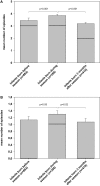Preterm Birth during Influenza Season Is Associated with Adverse Outcome in Very Low Birth Weight Infants
- PMID: 27965950
- PMCID: PMC5129678
- DOI: 10.3389/fped.2016.00130
Preterm Birth during Influenza Season Is Associated with Adverse Outcome in Very Low Birth Weight Infants
Abstract
Objective: We investigated the relationship between influenza seasonality and outcome of very low birth weight infants (VLBWI) in a large observational cohort study of the German Neonatal Network.
Materials and methods: Within the observational period (July 2009 until December 2014), five influenza seasons occurred (mean duration: 97 days, range: 48-131 days). We stratified VLBWI (n = 10,187) according to date of birth into three categories: (1) before influenza season, (2) during influenza season, and (3) 3 months after the end of the respective season. Outcomes were assessed in univariate and logistic regression analyses. In a subgroup of infants (n = 1497), the number of respiratory infections during the first 24 months of life was assessed.
Results: VLBWI born during influenza season carried a higher risk for clinical sepsis (31.0 vs. 28.2%; p = 0.014) and periventricular leukomalacia (PVL, 3.7 vs. 2.5%, p = 0.004). In a multivariate logistic regression model, birth during influenza season was associated with PVL [odds ratio (OR) 1.47 (1.11-1.95), p = 0.007] and clinical sepsis [OR 1.13 (1.01-1.27), p = 0.036], independent of known risk factors, i.e., gestational age, multiple birth, gender, and small for gestational age. The risk for bronchopulmonary dysplasia was not influenced by influenza seasonality. In the small subgroup with information on 24 months follow-up (n = 1497), an increased incidence of common cold and bronchitis episodes was noted in infants born during influenza season.
Conclusion: Our observational data indicate that preterm birth during influenza season is associated with PVL and sepsis. These are novel aspects that deserve further investigations to address underlying causes and to include virus surveillance.
Keywords: human; influenza; outcome; periventricular leukomalacia; seasonality; sepsis; very low birth weight infants.
Figures

Similar articles
-
Periventricular leukomalacia in very low birth weight preterm neonates with high risk for neonatal sepsis.J Pediatr (Rio J). 2008 May-Jun;84(3):211-6. doi: 10.2223/JPED.1777. Epub 2008 Apr 18. J Pediatr (Rio J). 2008. PMID: 18425215
-
Antifungal Treatment and Outcome in Very Low Birth Weight Infants: A Population-based Observational Study of the German Neonatal Network.Pediatr Infect Dis J. 2018 Nov;37(11):1165-1171. doi: 10.1097/INF.0000000000002001. Pediatr Infect Dis J. 2018. PMID: 29601449
-
Episodes of hypocarbia and early-onset sepsis are risk factors for cystic periventricular leukomalacia in the preterm infant.Early Hum Dev. 2012 Jan;88(1):27-31. doi: 10.1016/j.earlhumdev.2011.06.011. Epub 2011 Jul 12. Early Hum Dev. 2012. PMID: 21752559
-
Delivery mode and intraventricular hemorrhage risk in very-low-birth-weight infants: Observational data of the German Neonatal Network.Eur J Obstet Gynecol Reprod Biol. 2017 May;212:144-149. doi: 10.1016/j.ejogrb.2017.03.032. Epub 2017 Mar 22. Eur J Obstet Gynecol Reprod Biol. 2017. PMID: 28363188
-
[Risk factors for extrauterine growth retardation in very low birth weight infants: a multicenter study].Zhonghua Er Ke Za Zhi. 2020 Aug 2;58(8):653-660. doi: 10.3760/cma.j.cn112140-20200326-00308. Zhonghua Er Ke Za Zhi. 2020. PMID: 32842386 Chinese.
Cited by
-
Influenza in High-Risk Hosts-Lessons Learned from Animal Models.Cold Spring Harb Perspect Med. 2020 Dec 1;10(12):a038604. doi: 10.1101/cshperspect.a038604. Cold Spring Harb Perspect Med. 2020. PMID: 31871227 Free PMC article. Review.
-
Biological Sex and Pregnancy Affect Influenza Pathogenesis and Vaccination.Curr Top Microbiol Immunol. 2023;441:111-137. doi: 10.1007/978-3-031-35139-6_5. Curr Top Microbiol Immunol. 2023. PMID: 37695427
-
Exploring modifiable risk-factors for premature birth in the context of COVID-19 mitigation measures: A discussion paper.J Neonatal Nurs. 2021 Jun;27(3):172-179. doi: 10.1016/j.jnn.2020.11.004. Epub 2020 Nov 4. J Neonatal Nurs. 2021. PMID: 33169065 Free PMC article. Review.
-
The Importance of Vaccinating Children and Pregnant Women against Influenza Virus Infection.Pathogens. 2019 Nov 26;8(4):265. doi: 10.3390/pathogens8040265. Pathogens. 2019. PMID: 31779153 Free PMC article. Review.
-
H1N1 influenza virus infection results in adverse pregnancy outcomes by disrupting tissue-specific hormonal regulation.PLoS Pathog. 2017 Nov 27;13(11):e1006757. doi: 10.1371/journal.ppat.1006757. eCollection 2017 Nov. PLoS Pathog. 2017. PMID: 29176767 Free PMC article.
References
-
- Uchide N, Ohyama K, Bessho T, Toyoda H. Induction of pro-inflammatory cytokine gene expression and apoptosis in human chorion cells of fetal membranes by influenza virus infection: possible implications for maintenance and interruption of pregnancy during infection. Med Sci Monit (2005) 11:RA7–16. - PubMed
LinkOut - more resources
Full Text Sources
Other Literature Sources

